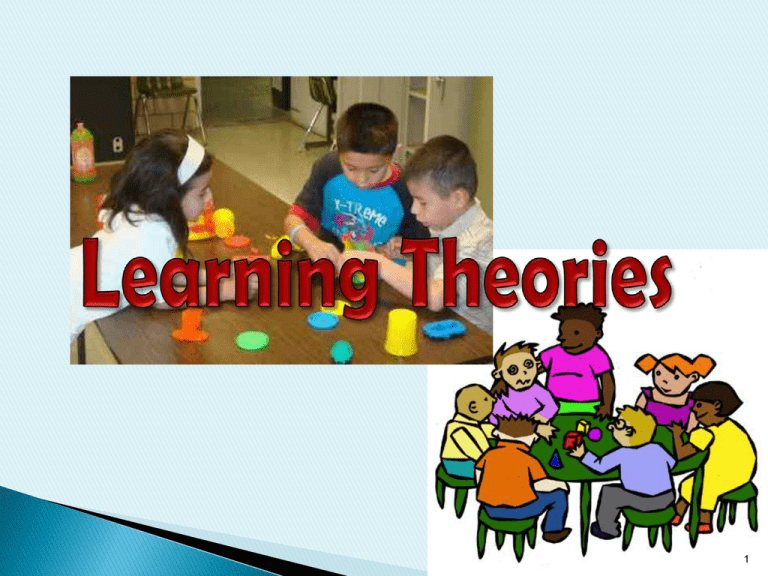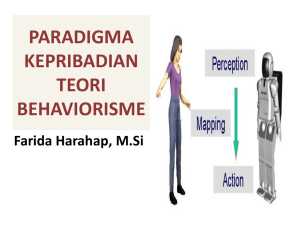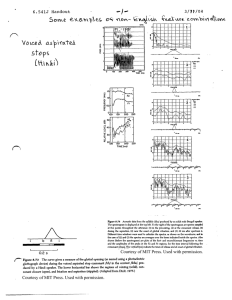1
advertisement

1 Learning is an alteration of behavior as a result of individual experience. When an organism can perceive and change its behavior, it is said to learn. “Learning is a relatively permanent change in a behavioral tendency and is the result of reinforced practice.” (Kimble & Garmezy, Principles of General Psychology, 1963:133) Learning is a persisting change in performance or performance potential that results from experience and interaction with the world (Marcy P. Driscoll) Learning theory is a set of law a principle about learning (Marcy Driscoll) 3 Actualization Esthetic Cognitive Secondary Needs Self-esteem Love/affection Safety Primer Needs Physics Understand the rational (theories) behind common teaching practices Theories as guide and inspiration for different teaching techniques Theories provide language of the teaching profession; discuss education issues with colleagues 5 Behavoristic theories Classical behaviorism Pavlov’s classical conditioning Thorndike’s instrumental conditioning Watson’s behaviorism Neobehaviorism Guthrie’s S-R theory Hull’s S-R theory Skinner’s operant conditioning Constructivistic theories Gestalt psychology Piaget’s developmental psychology Ausubel’s theory of meaningful learning Behaviorism Constructivism Humanism Cognitivism Stimulus Stimulus Stimulus Respon Black box Reward Punishment CONSTRUCTIVISM Stimulus Stimulus Stimulus PROSES + ENVIRON MENT Respon Attribute Behaviorism Cognitivism Behaviors The end in themselves- the only observable truth Evidence pointing to brain activitylearning Activation of Prior Knowledge Irrelevant Essential Teachers role Provide stimulus Prepare environment 5305 Curriculum Design, Implementation and Evaluation 10 TEORI BELAJAR BEHAVIORISME Study tentang Tingkah laku teramati p b m Latihan berulang/drill Motivasi ekstrinsik Belajar: S - R Hasil belajar: - Well-structured knowledge Belajar jika: - Basic skills - ada stimulus - siap mental - Teacher-centered - Direct instruction/Active teaching/ Mastery teaching Not much interested in how people “think” mentally Primarily concerned with observable behavior, I.e., what happens before and after learning In this sense, behavioral instruction (direct instruction, programmed learning, etc.) is mostly concerned with what the teacher does Deterministic- The way you act is determined by external stimuli provided by the culture in which you live. Observable- Over time the individual develops a “behavioral repertoire” (Steinberg, 1980) that can be used to predict behavior. Controllable- Desirable behaviors can be brought about by incentives or rewards; undesirable behaviors can be eradicated by consequences or punishment. 14 Scenario Teacher explain and demonstrate how to perform a rule, e.g., 34 + 47 = 81 Pupils listen and pay attention Pupils practice rule with other examples Teacher rewards those who can do Teacher re-explain to those who make mistakes 15 Behaviourism: Traditional Stimulus Response 12 x 12 = …. 13 x 12 – 12 = …. 16 Traditional chalk and talk method: explain practice feedback Based on behaviourism: learning consist of change in observable, measurable behaviours based on stimulus (S) and responses (R) 17 Russian physiologist and Nobel laureate, best known for his studies of reflex behavior. He was born in Ryazan', and educated at the University of Saint Petersburg and at the Military Medical Academy, Saint Petersburg; from 1884 to 1886 he studied in Breslau (now Wroclaw, Poland) and Leipzig, Germany. Before the Russian Revolution he served as director of the department of physiology at the Institute of Experimental Medicine (part of the present Academy of Medical Sciences), Saint Petersburg, and professor of medicine at the Military Medical Academy. In spite of his opposition to Communism, Pavlov was allowed to continue his research in a laboratory built by the Soviet Government in 1935. Pavlov is noted for his pioneer work in the physiology of the heart, nervous system, and digestive system. His most famous experiments, begun in 1889, demonstrated the conditioned and unconditioned reflexes in dogs, and they had an influence on the development of physiologically oriented behaviorist theories of psychology during the early years of the 20th century. His work on the physiology of the digestive glands won him the 1904 Nobel Prize in physiology or medicine. His major work is Conditioned Reflexes (1926; trans. 1927). 20 21 22 23 Key Players: 1. Pavlov (and Watson) – Classical Conditioning 2. Thorndike – Connectionism 3. Skinner – Operant Conditioning 4. Bandura – Observable Learning and Modeling 5. Gagné – Hierarchical Learning 5305 Curriculum Design, Implementation and Evaluation 24 (1849 – 1936) ◦ Pavlov was the first to demonstrate Classical Conditioning. ◦ He is best known for his experiment with salivating dogs. ◦ Classical Conditioning Eliciting an unconditioned response by using previously neutral stimuli. Unconditioned stimuli create reflexes that are not “learned,” but are instinctual. Neutral and unconditioned stimuli are introduced at the same time. Unconditioned stimuli are gradually removed, and the neutral stimuli elicit the same reflex. "Pavlov's Drooling Dogs." [Online image] 1 February 2009. <http://http://nobelprize.org/educational_ games/medicine/pavlov/readmore.html> 5305 Curriculum Design, Implementation and Evaluation 25 Behavior berarti tindakan (action) yang dapat dilihat dan diamati dengan cara yang obyektif Belajar adalah proses membentuk hubungan S-R Kekuatan hubungan S-R tergantung pada frekuensi ulangan adanya S-R Pentingnya drill dalam pembelajaran Hubungan S-R diperkuat oleh reinforcement (pujian/ganjaran) Dalam menjelaskan suatu konsep, guru hendaknya mengambil contoh yang sering dijumpai dalam kehidupan sehari-hari. Metode pemberian tugas dan metode latihan (drill and practice) akan lebih cocok. Dalam kurikulum, materi disusun dari yang mudah-sedang-sukar sesuai dengan tingkat kelas, dan tingkat sekolah. Teori operant conditioning Tingkah laku tidak hanya respon dari stimulus, tetapi suatu tindakan yang disengaja Replaced behaviorism as dominant philosophy in 1960’s 1. Criticisms of Behaviorism: Did not explain: language learning why people respond differently to the same stimulus reinforcement can reduce motivation 2. Popularity of newly discovered theories of Piaget and Vygotsky in the 50’s and 60’s 29 5305 Curriculum Design, Implementation and Evaluation Kognitivisme: Koffka, Kohler, Wetheimer, Ausubel, Piaget, Bruner, dan Dienes; Humanisme: Vygotksy Pandangan Konstruktivisme: Belajar adalah: - proses aktif dan konstruktif yang terjadi di lingkungan luar kelas - mengubah informasi menjadi proses mental - membangun pengetahuan dan pengertian dari pengalaman pribadi - mengaitkan pengetahuan baru dg pengalaman lama (asimilasi) - membangun pengetahuan baru dr fenomena lama (akomodasi) - proses kognitif untuk memecahkan masalah dunia nyata, menggunakan alat yang tersedia dalam situasi pemecahan masalah - bersifat situasional, interaktif - bekerja dengan teman dalam konstruksi sosial yang berarti bagi dirinya - proses pribadi terus-menerus untuk memonitor kemajuan belajar Pandangan Konstruktivisme (lanjutan): Pengetahuan: - merupakan interpretasi manusia terhadap pengalamannya tentang dunia - bersifat perspektif, konvensional, tentatif, evolusioner - ada di dalam pikiran manusia (bukan di buku teks) - pengetahuan/konsep baru dibangun: + bertahap dari waktu ke waktu + dalam konteks sosial + interaksi dengan konten + dengan mengintegrasikan info lama dg info baru + dengan kesadaran ttg apa yang dipelajari (metakognisi) TEORI BELAJAR KOGNITIVISME Studi tentang p b m Proses/ perubahan kognitif Hasil belajar: Belajar: interaksi/adaptasi dg lingkungan - Life skills - Perkembangan struktur kognitif - Adult role behaviors - Self-regulated learning Belajar: Pembelajaran: Asimilasi – Akomodasi – - Konstruktivisme Ekuilibrium - Diskoveri-inkuiri - PBL Perkembangan kognitif - Kontekstual/STS/Salingtemas Hukum pragnanz: organisasi psikologis selalu cenderung untuk bergerak ke keadaan penuh arti. Hukum kesamaan: hal-hal yang sama cenderung akan membentuk Gestal (kesatuan) Hukum keterdekatan: hal-hal yang saling berdekatan cenderung membentuk kesatuan Hukum ketertutupan: hal-hal yang tertutup cenderung membentuk kesatuan Hukum kontinyuitas: hal-hal yang kontinyu atau berkesinambungan akan cenderung membentuk kesatuan Bahan pelajaran akan lebih mudah dipahami jika bahan itu dirasakan bermakna bagi siswa Kebermaknaan: sesuai dengan struktur kognitif, sesuai struktur keilmuan, memuat keterkaitan Seluruh bahan (ihtisar/resume/rangkuman/ringkasan/ bahan/peta) Peta konsep adalah bagan / struktur tentang keterkaitan seluruh konsep secara terpadu / terorganisir (herarkhis, distributive/menyebar) merupakan teori konflik sosiokognitif yang berkembang menjadi aliran konstrukstivistik kemauan belajar anak banyak ditentukan oleh karsa individu keaktifan siswa merupakan faktor dominan keberhasilan belajar kemandirian merupakan jaminan ketercapaian hasil belajar yang optimal penataan lingkungan bukan penentu terjadinya belajar, tetapi mempermudah belajar bisa berakibat kontraproduktif, budaya individualistik dan sokratik (self-generated knowledge – individualistic pursuit of truth), unggulan budaya barat teori psikogenesis: pengetahuan berasal dari individu, posisi siswa terpisah dengan interaksi sosial, penciptaan makna / pengetahuan akibat kematangan biologis, primer (individu) – sekunder (sosial). mengutamakan interaksi dalam kelompok sebaya, bukan yang lebih dewasa Klasifikasi perkembangan kognitif: sensory motor, pra operasional, operasional konkrit, dan operasional formal. Asumsi: konsep tersusun dalam jaringan laba-laba yang disebut skemata, konsep terkait akan terhubung: perlunya mengkaitkan pengetahuan baru dengan yang sudah ada, pengetahuan prasyarat memudahkan siswa memahami konsep. Perubahan struktur kognitif melalui adaptasi yang berimbang (equlibrasi): dengan proses asimilasi dan akomodasi enactive (manipulasi obyek langsung) iconic (representasi gambar) symbolic (manipulasi simbol) Dengan permainan siswa menjadi lebih tertarik dan tidak bosan terhadap bahan pelajaran yang diberikan Prosedur: memahami, merencanakan, melaksanakan, mengecek Ciri: siswa tertentang, tidak ada prosedur tetap, ada usaha Model: tidak rutin, soal cerita, soal terapan Strategi: penemuan terbimbing (guided discovery), investigasi, multiple solution, multiple methods of solution Pengembangan: Higher Order Thinking (kritis, kreatif, analitik) Proses: persiapan (koleksi, informasi, pengamatan, penyelidikan, pendapat) Analisis (definisi, klasifikasi, evaluasi) Inkubasi (pengendapan dalam pikiran) Iluminasi (munculnya ide baru tak terduga) Usaha sadar menjawab / menyelesaikan TEORI BELAJAR HUMANISME p b m Landasan teori - Menentang sistem otoriter Pendekatan PBM: - Memandang siswa dari - Berpusat Siswa (fasilitatif) sudut siswa - Pendidikan Multikultural - Belajar Sosial (Bandura) Belajar: - Scaffolding (Vigotsky) - Mengubah lingkungan - Motivasi intrinsik Pembelajaran: - Bebas dari ancaman - Modeling - Terarah/tujuan sendiri - Belajar Kooperatif - Bermakna bagi diri sendiri - STS/Kontekstual 46 47 48 49 50 51 52 53 54 55 56

